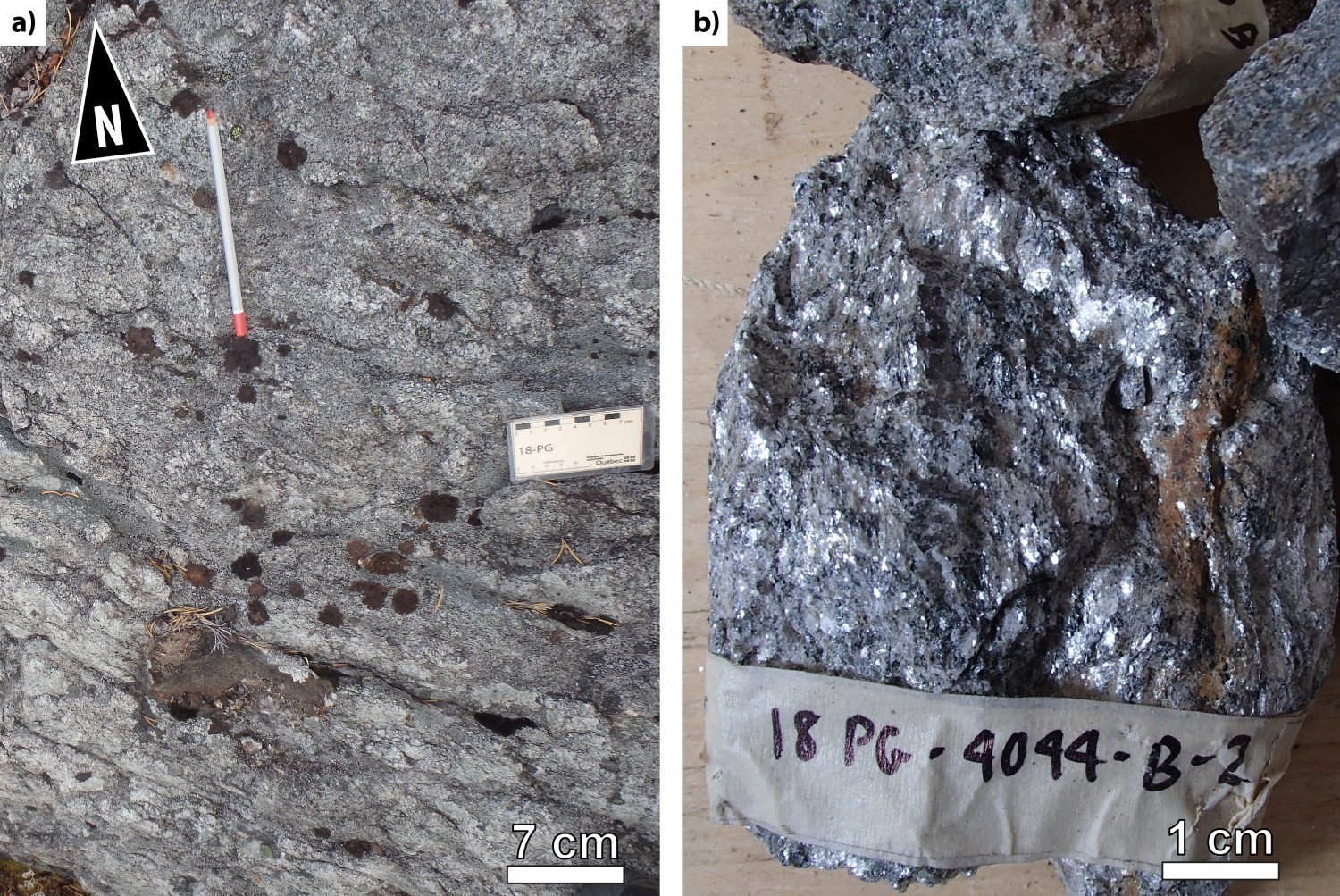
| Author(s) | Beauchamp, 2019 |
| Methodology | Defined from geological survey |
| Geological(s) subdivision(s) | Superior Province / Opatica Subprovince |
| Main movement | Does not apply |
| Deformation style | Homogeneous |
| Metamorphic facies (mean facies related to main deformation) | Undetermined |
Background and Methodology
The Cadieux Structural Domain was defined by Beauchamp (2019) following a mapping survey conducted in the Cadieux Lake area in the summer of 2018. It includes intrusive rocks of the Opatica Subprovince. The following description is based primarily on geological observations collected by Beauchamp (2019), as well as analysis of aeromagnetic surveys from SIGÉOM.
Boundaries and Morphology
| Width | 12-15 km |
| Length | 45 km (sheet 33A07 only) |
| Orientation | ENE-WSW elongation |
The Cadieux Structural Domain is a relatively large domain (45 km by 15 km). It occupies one third of the map produced by Beauchamp (2019). Metasedimentary rocks of the Ayr Structural Domain mark the northern limit of the Cadieux Domain. The Digne Shear Zone borders the southern contact between the Cadieux and Dolent domains. Finally, the Cadieux Domain is in intrusive contact with the Eastmain-Sorbier Shear Zone.
Stratigraphic Units Concerned
The Cadieux Structural Domain is composed of intrusive rocks of the Opatica Subprovince. It comprises the following stratigraphic units:
- the MacLeod Batholith (nAmcl);
- the Misasque Complex (Amiq);
- the Digne Pluton (mAdig).
Structural Characteristics
À REMPLACER
❯ Main Fabrics
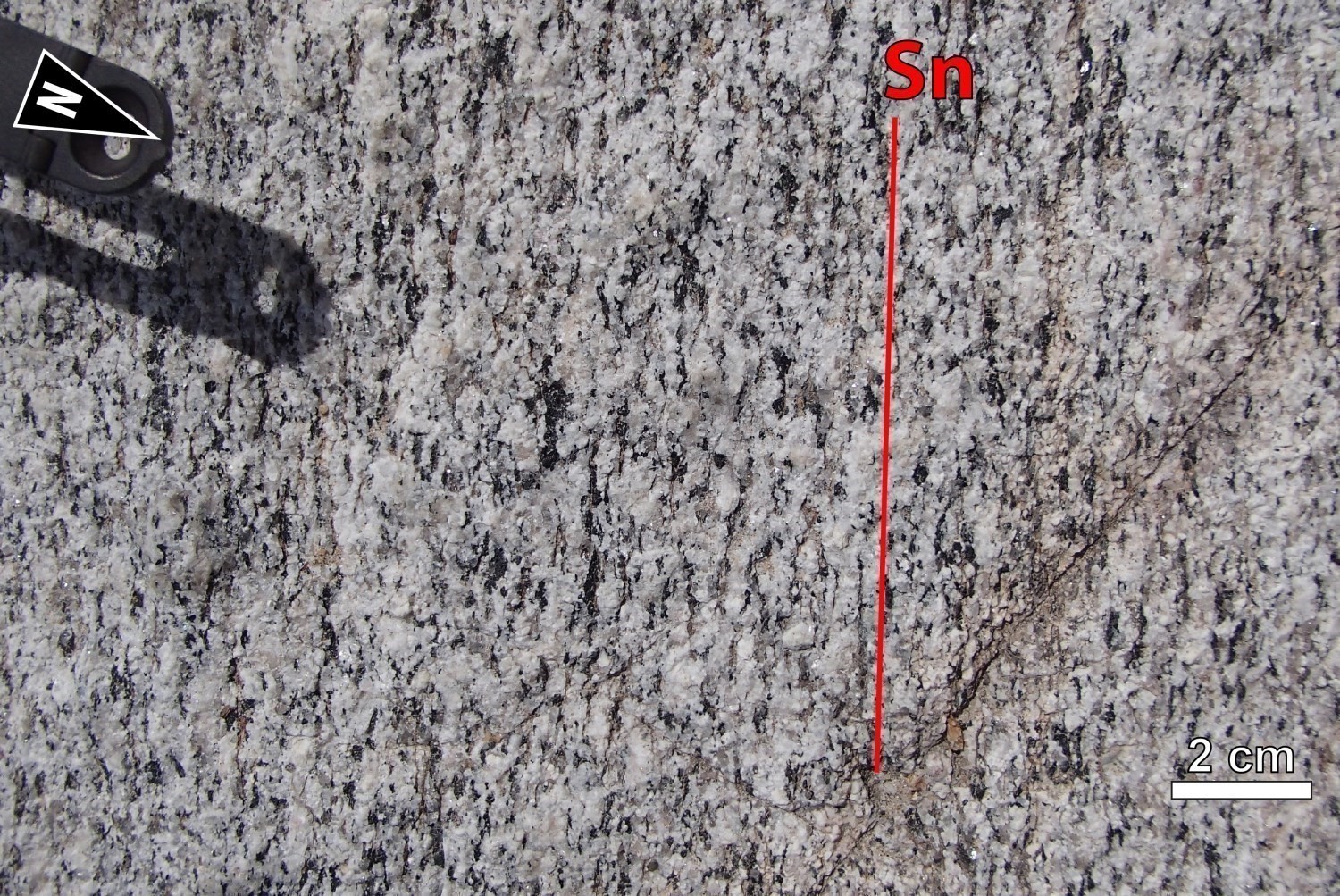
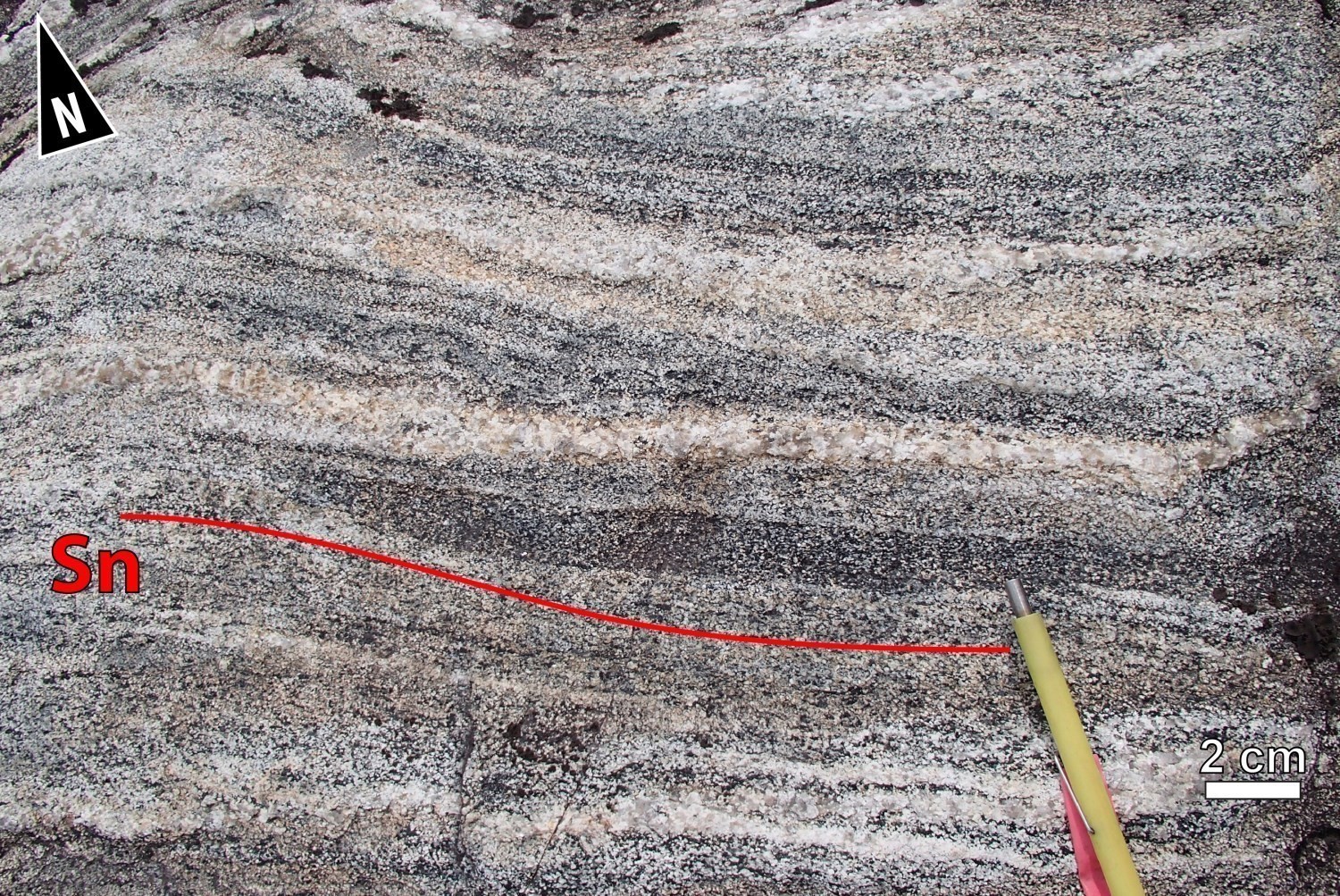
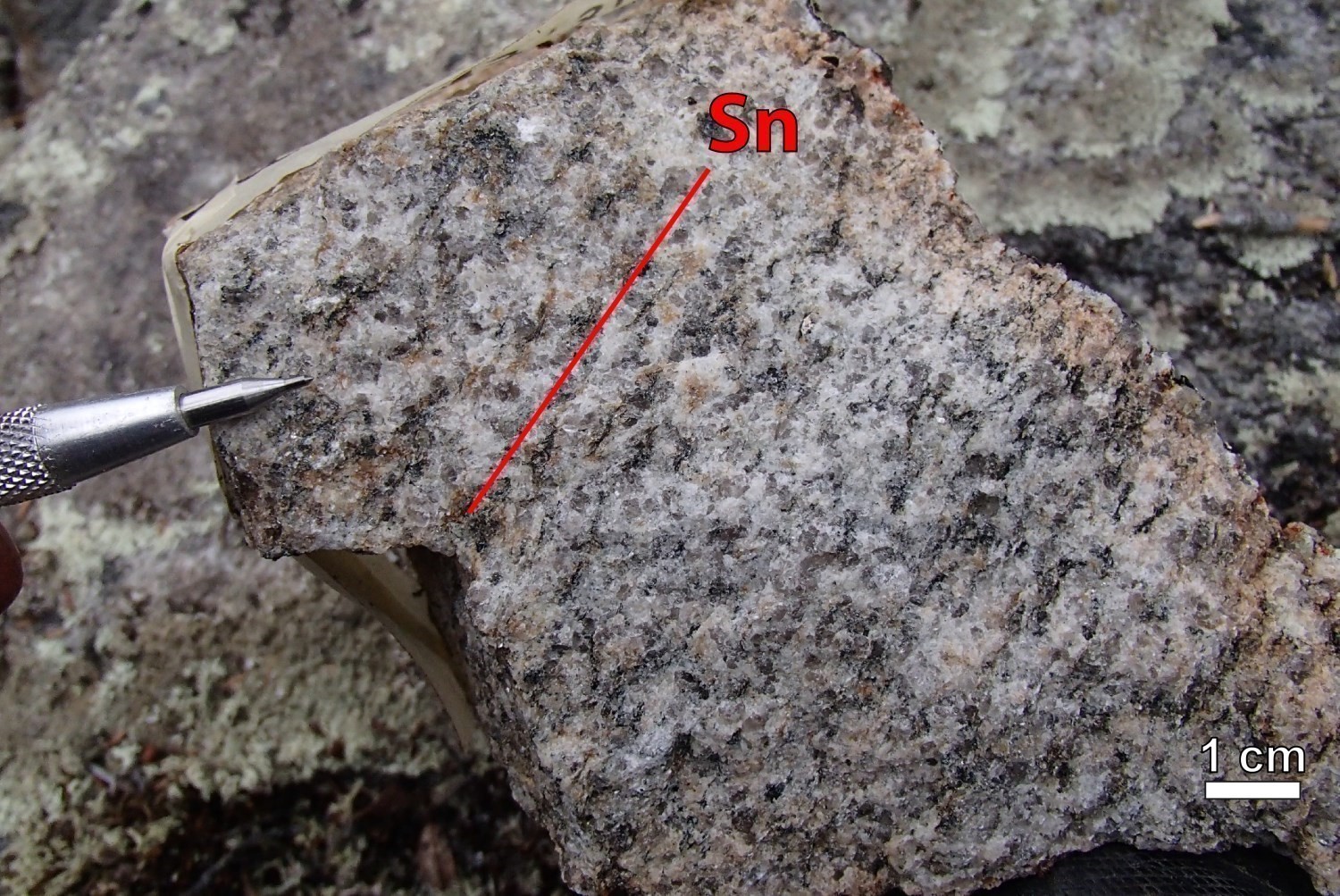

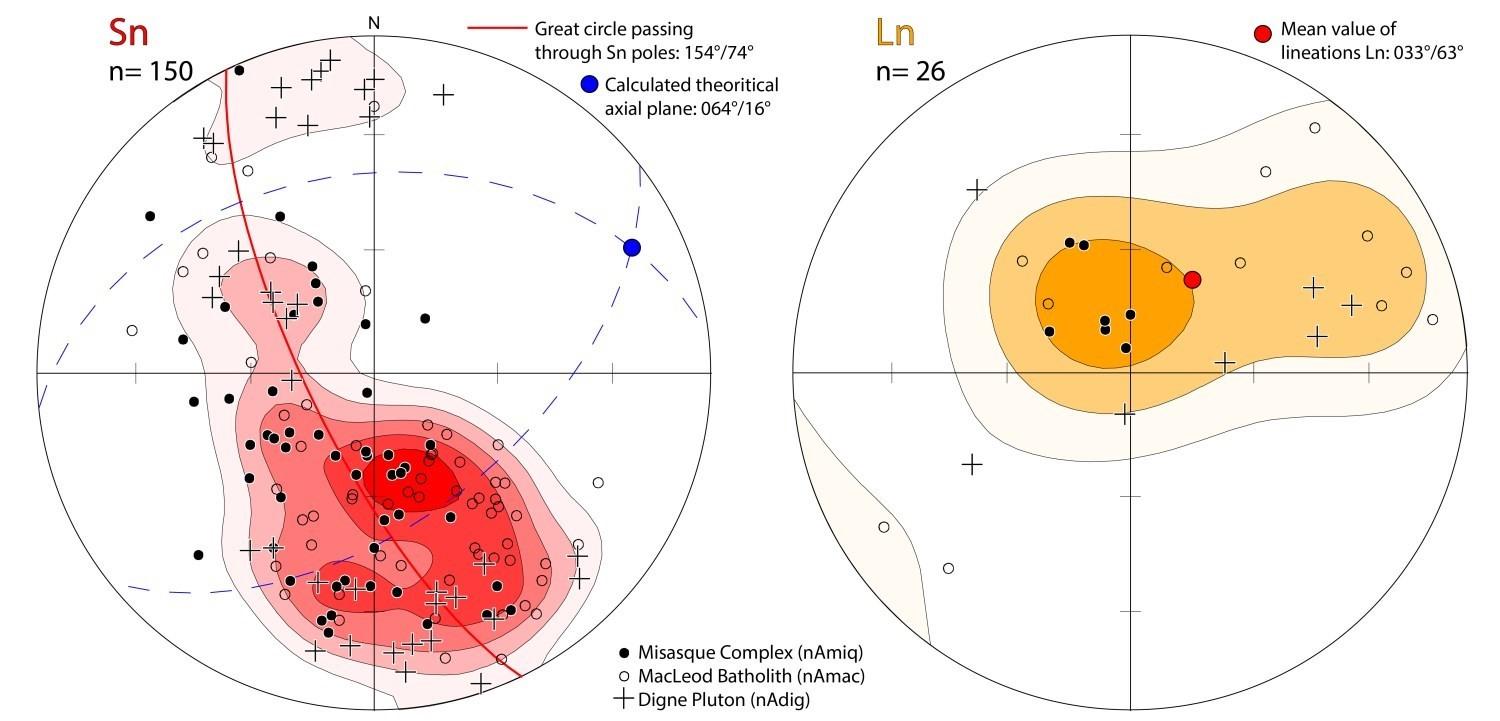 The main Sn fabric present in the Cadieux Structural Domain is a moderately developed penetrative foliation defined by the preferential alignment of ferromagnesian minerals (biotite, hornblende) affecting the MacLeod Batholith and Digne Pluton. Millimetric to centimetric lenses of ferromagnesian minerals and foliated granoblastic diorite enclaves are aligned along the main foliation Sn in the MacLeod Batholith. In the Misasque Complex, the main fabric is rather marked by irregular and contrasting sharp gneissosity, forming alternating mafic (biotite ± hornblende) and whitish quartzofeldspathic layers, and accentuated by the presence of subconformable granitic injections.
The main Sn fabric present in the Cadieux Structural Domain is a moderately developed penetrative foliation defined by the preferential alignment of ferromagnesian minerals (biotite, hornblende) affecting the MacLeod Batholith and Digne Pluton. Millimetric to centimetric lenses of ferromagnesian minerals and foliated granoblastic diorite enclaves are aligned along the main foliation Sn in the MacLeod Batholith. In the Misasque Complex, the main fabric is rather marked by irregular and contrasting sharp gneissosity, forming alternating mafic (biotite ± hornblende) and whitish quartzofeldspathic layers, and accentuated by the presence of subconformable granitic injections.
The MacLeod Batholith and Misasque Complex are characterized by poorly developed lineations Ln defined by the stretching of hornblende. Lineation Ln is best developed in the southern part of the Digne Pluton, especially approaching the Digne Shear Zone. Lineations Ln are also very present in highly granoblastic diorite and gabbro enclaves found in the Misasque Complex and Digne Pluton. These intermediate to mafic rocks are the oldest units within intrusive suites and commonly form L>S tectonites.
At the scale of the Cadieux Structural Domain, even if foliation Sn seems mainly oriented ENE-WSW and have a moderate dip, its attitude is still variable. On the map, these variations, both in terms of orientation and dip, indicate that it is folded. Foliation Sn locally bears a mineral lineation Ln which often dips towards the NE at a moderate angle.
| Main Fabric | Type of Fabric | Direction (°) | Dip / Plunge (°) | Number of Measurements | Comments |
| Foliation Sn | Tectonometamorphic foliation and gneissosity | 264 | 40 | 150 | Some measurements are spread out along a great circle which passes through the poles of foliations Sn (154°/74°). This indicates that the Sn fabric is folded. |
| Lineation Ln | Stretch lineation and mineral lineation | 033 | 63 | 26 |
The plunge of lineations vary globally from NW to NE. |
❯ Other Fabrics
Not observed.
❯ Folds
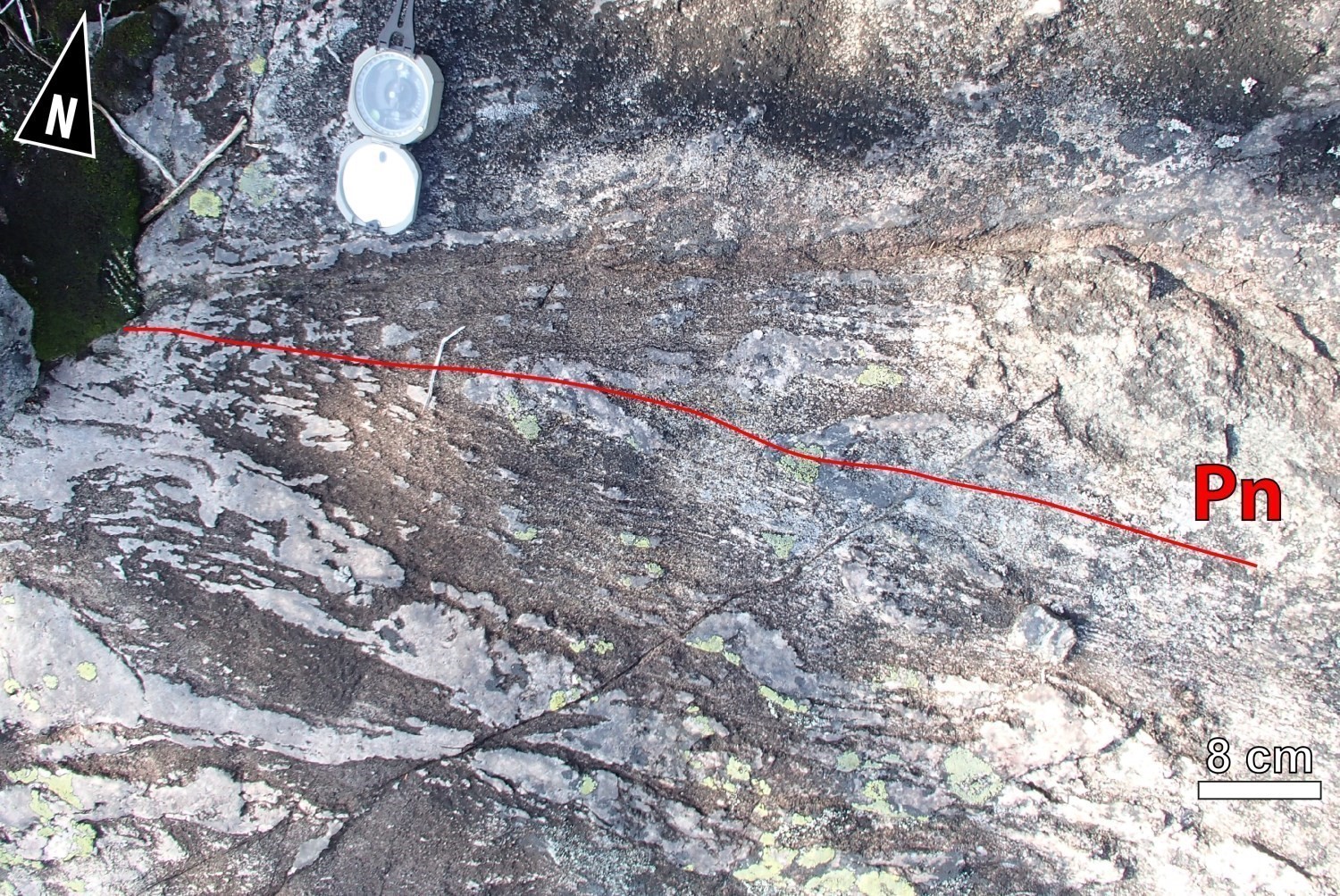 The MacLeod Batholith is structurally very homogeneous. It is foliated by Sn, and a mineral lineation Ln is present in places. Magnetic maps available on SIGÉOM (tilt and vertical gradient) and Rapid Eye Imagery indicate that the MacLeod Batholith is affected by a succession of antiformal and synformal folds. However, a very small percentage of outcrops visited exhibited folding. Outcrop 18-FM-2075, located at the edge of the batholith, exposes diorite intensely deformed by a succession of tight to isoclinal folds. The E-W axial trace is particularly evident in felsic injections and silicified zones which are folded and in positive relief in diorite. Outcrop 18-PG-4080 also reveals that quartz monzodiorite and granitic injections are folded by Pn. The MacLeod Batholith appears to be saucer-shaped.
The MacLeod Batholith is structurally very homogeneous. It is foliated by Sn, and a mineral lineation Ln is present in places. Magnetic maps available on SIGÉOM (tilt and vertical gradient) and Rapid Eye Imagery indicate that the MacLeod Batholith is affected by a succession of antiformal and synformal folds. However, a very small percentage of outcrops visited exhibited folding. Outcrop 18-FM-2075, located at the edge of the batholith, exposes diorite intensely deformed by a succession of tight to isoclinal folds. The E-W axial trace is particularly evident in felsic injections and silicified zones which are folded and in positive relief in diorite. Outcrop 18-PG-4080 also reveals that quartz monzodiorite and granitic injections are folded by Pn. The MacLeod Batholith appears to be saucer-shaped.
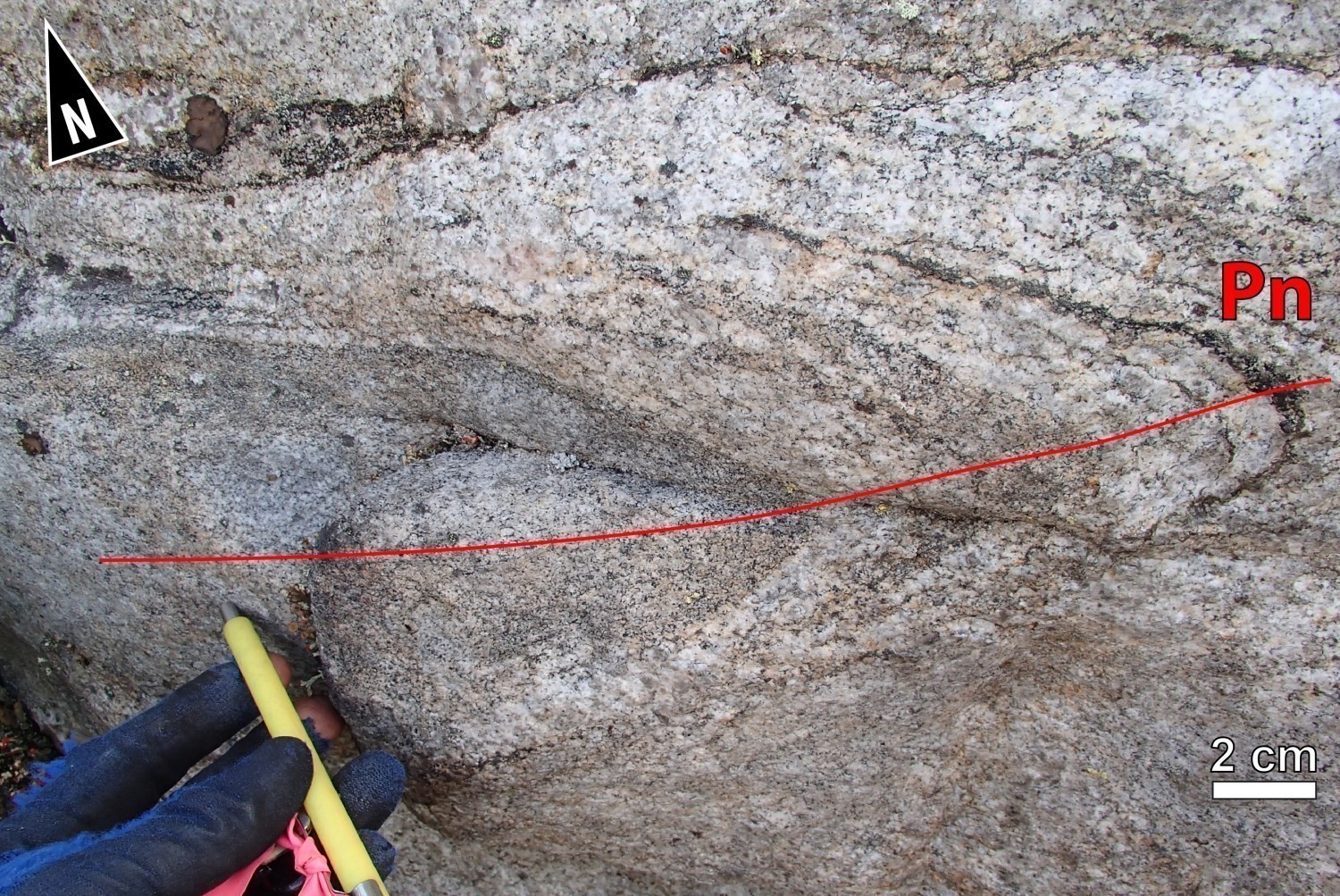 The Misasque Complex is very heterogeneous. It consists of a banded sequence of tonalite, quartz diorite and diorite injected by several generations of granite. A few Pn folds can be recognized on outcrops through magmatic flow textures.
The Misasque Complex is very heterogeneous. It consists of a banded sequence of tonalite, quartz diorite and diorite injected by several generations of granite. A few Pn folds can be recognized on outcrops through magmatic flow textures.
Although Sn foliation measurements tend to demonstrate that the Digne Pluton is also folded, no fold structure was observed on outcrops.
Geometric Parameters of Regional Folds:
| Fold or Family of Folds | Type (Anticline, Syncline or Undetermined) | Shape (Antiform or Synform) | Attitude (Overturned or Upright) | Axial Plane | Fold Axis | Position (Certain or Probable) | Deformation Phase | Comments | ||
| Direction | Dip | Direction | Dip | |||||||
| Plis Pn | Undetermined | Antiform and synform | Mostly overturned, some upright | ENE-WSW | Unknown | – | – | Certain and probable | Dn | |
❯ Crosscutting Relationships
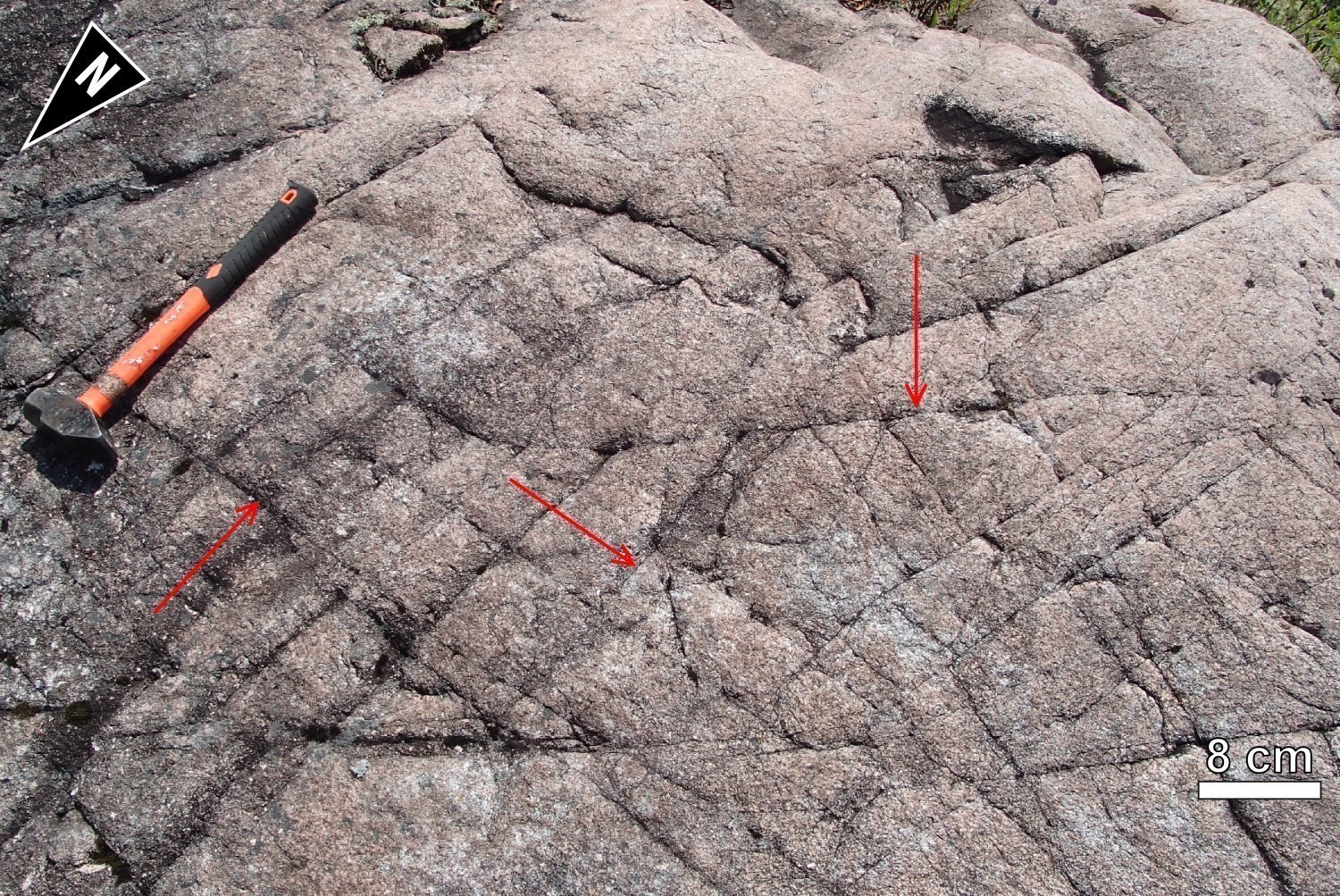
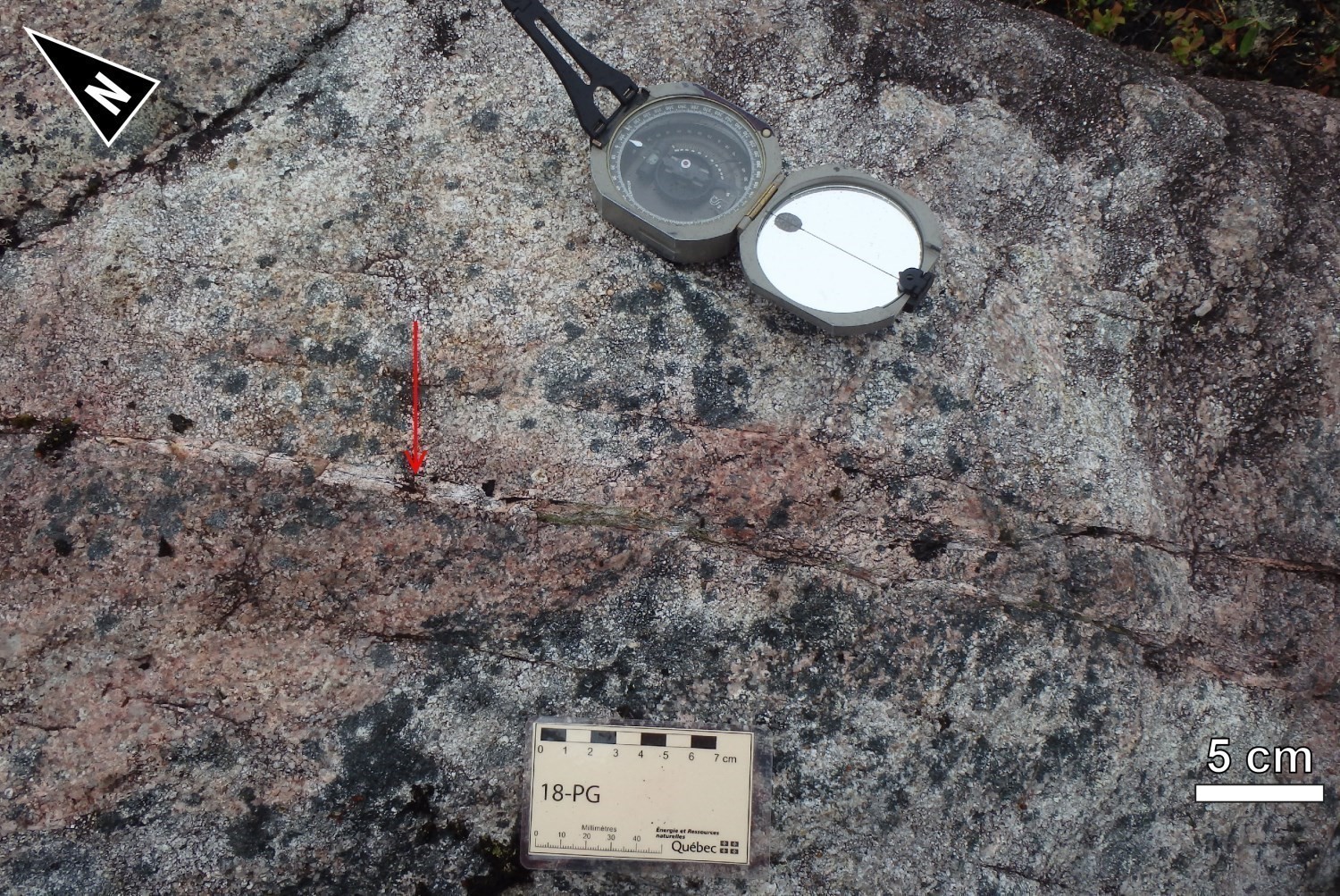 The Cadieux Structural Domain is cut by late faults that were inferred from the analysis of magnetic field maps. These families of faults, with apparent dextral and sinistral displacement, locally offset intrusive units of the Opatica Subprovince. Some field evidence indicates that they consist of little altered fault networks <1 m wide. Some fractures cutting the MacLeod Batholith and Misasque Complex are hematitized and/or epidotized.
The Cadieux Structural Domain is cut by late faults that were inferred from the analysis of magnetic field maps. These families of faults, with apparent dextral and sinistral displacement, locally offset intrusive units of the Opatica Subprovince. Some field evidence indicates that they consist of little altered fault networks <1 m wide. Some fractures cutting the MacLeod Batholith and Misasque Complex are hematitized and/or epidotized.
Geometric Parameters of Regional Faults Cutting the Cadieux Structural Domain:
| Fault or Family of Faults | Type | Mean Direction (°) | Mean Dip (°) | Lineation Plunge in the Fault Plane | Estimated Width (m) | Estimated Length (km) | Apparent Movement | Position | Comments |
| Family of fauts | – | NNW-SSE – NW-SE | Steep | Unknown | <1 | >1 | Dextral | Probable | |
| Family of fauts | – | E-W | Steep | Unknown | <1 | >1 | Sinistral | Probable |
❯ Kinematics
Does not apply.
Deformation Style
This structural domain is relatively homogeneous and mainly affected by regional deformation Dn, which consists of NNW-SSE shortening.
Metamorphic Characteristics
The mineralogical composition of intrusive rocks belonging to the Opinaca Subprovince does not allow establishing the metamorphic conditions that these rocks underwent. Since rocks of the adjacent structural domains have reached the amphibolite facies, it is very likely that rocks of the Cadieux Structural Domain also reached these pressure and temperature conditions.
Alterations
The MacLeod Batholith is characterized by weak to severe alteration that appears to be zoned. Potassic alteration (biotite, magnetite and K-feldspar in variable amounts) is present in the centre of the intrusion. Propylitic alteration (quartz, chlorite and epidote) and silicification are located at the edge of the intrusion. Later hematite-epidote veinlets cut foliation Sn, and remobilize part of the Cu-Mo-Ag-Au-W mineralization hosted in the MacLeod Batholith and in metasedimentary units surrounding the intrusion.
Rocks of the Digne Pluton have undergone muscovitization, which seems to be of hydrothermal origin and which transforms feldspars into an assemblage dominated by quartz and muscovite. Some outcrops expose anastomosing networks of muscovite veins and quartz veins (outcrops 18-PG-4044, 18-PG-4045 and 18-PG-4046).
Finally, apart from hematitization and epidotization of certain outcrops, the Misasque Complex does not seem to be particularly altered.
Geophysical Characteristics
SIGÉOM total magnetic field and magnetic gradient maps reveal that this domain is heterogeneous.On the total magnetic field map, the Misasque Complex and MacLeod Batholith are characterized by high magnetic susceptibility. A banded texture defines the domain for rocks of the Misasque Complex while the MacLeod Batholith has a smooth and homogeneous texture. The Digne Pluton is very homogeneous and has low magnetic susceptibility. On the vertical gradient map, the MacLeod Batholith is distinguished by a signature with stronger texture and contrast. Magnetic lineaments, some of which are similar to the trace of regional foliation Sn, are predominantly straight. Some lineaments are undulating, indicating the presence of possible folds. Families of brittle fractures are very apparent on magnetic maps.
Chronological Markers
Deformation Dn is postdating the emplacement of the Digne Pluton (2814 ±7 Ma, Davis, 2019). It is later or synchronous with the emplacement of the MacLeod Batholith (2704 ±2 Ma, Davis, 2019) and the youngest tonalitic phase dated in the Misasque Complex (2695 ±8 Ma, Davis and Sutcliffe, 2018; 2698 ±28 Ma, Davis, 2019). It predates 2640 Ma (Davis and Sutcliffe, 2018) corresponding to the age of the Wahemen Suite which is unaffected by deformation and metamorphism.
References
Publications Available Through Sigéom Examine
BEAUCHAMP, A.-M., MASSEI, F. 2019. Géologie et potentiel minéral de la région du lac Cadieux, sous-provinces d’Opatica et d’Opinaca, Eeyou Istchee Baie-James, Québec, Canada. MERN; BG 2019-02, 2 plans.
DAVIS, D.W., 2019. Rapport sur les datations U-Pb de roches du Québec 2018-2019, projets Lac Cadieux et Lac Watts. UNIVERSITY OF TORONTO; MB 2019-09, 82 pages.
Davis, D.W., Sutcliffe, C.N. 2018. U-Pb Geochronology of Zircon and Monazite by LA-ICPMS in samples from northern Quebec. UNIVERSITY OF TORONTO; MB 2018-18, 54 pages.
Suggested Citation
Contributors
|
First publication |
Anne-Marie Beauchamp, P. Geo., M.Sc. anne-marie.beauchamp@mern.gouv.qc.ca (redaction) Ghyslain Roy, P. Geo. (coordination); Patrice Roy, P. Geo., Ph.D. (critical review); Simon Auclair, P. Geo., M.Sc. (editing); Ricardo Escobar (HTML editing); Céline Dupuis, P. Geo., Ph.D. (English version) |


